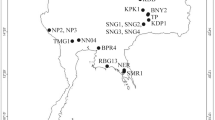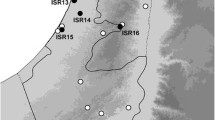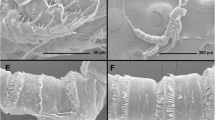Abstract
Morphological identification methods do not provide reliable and meaningful species identifications for taxa where morphological differences among distinct species are either absent or overlooked (i.e., cryptic species). For example, due to the minute nature of the morphological characters used to delineate diaptomid copepod species and the apparent potential for copepod speciation to occur with little or no morphological change (i.e., morphological stasis), morphological identifications of diaptomid species may not adequately capture their true species diversity. Here, we present results from a geographic survey of mtDNA sequences from populations across the geographic ranges of four North American diaptomid species—Leptodiaptomus minutus, Skistodiaptomus pallidus, Skistodiaptomus reighardi, and Onychodiaptomus sanguineus. Shallow mitochondrial DNA sequence divergences (maximum of 1.1%) among haplotypes of L. minutus from across its geographic range suggest that current morphological identification techniques reliably identify this species. In contrast, we found large mitochondrial DNA sequence divergences (14–22%) among populations within the currently recognized morphospecies of S. pallidus, S. reighardi, and O. sanguineus. However, pairwise sequence divergences within four distinct S. pallidus clades and within populations of S. reighardi and O. sanguineus were similarly low (maximum of 1.5%) as found within L. minutus as a whole. Thus, the S. pallidus, S. reighardi, and O. sanguineus morphospecies may be considered best as cryptic species complexes. Our study therefore indicates that morphological identifications, while sufficient for some species, likely underestimate the true species diversity of diaptomid copepods. As such, we stress the need for extensive taxonomic revision that integrates genetic, morphological, reproductive, and ecological analyses of this diverse and important group of freshwater zooplankton. Furthermore, we believe an extensive taxonomic revision will shed important insight into major questions regarding the roles of geography, phylogeny, and habitat on the frequency of cryptic species on earth.




Similar content being viewed by others
References
Adamowicz, S. J., S. Menu-Marque, P. D. N. Hebert & A. Purvis, 2007. Molecular systematics and patterns of morphological evolution in the Centropagidae (Copepoda : Calanoida) of Argentina. Biological Journal of the Linnean Society 90: 279–292.
Bickford, D., D. J. Lohman, N. S. Sodhi, P. K. L. Ng, R. Meier, K. Winker, K. K. Ingram & I. Das, 2007. Cryptic species as a window on diversity and conservation. Trends in Ecology & Evolution 22: 148–155.
Bucklin, A., B. W. Frost, J. Bradford-Grieve, L. D. Allen & N. J. Copley, 2003. Molecular systematic and phylogenetic assessment of 34 calanoid copepod species of the Calanidae and Clausocalanidae. Marine Biology 142: 333–343.
Burr, B. & R. Mayden, 1992. Phylogenetics and North American freshwater fishes. In Mayden, R. (ed.), Systematics, historical ecology, and North American freshwater fishes. Stanford University Press: 18–75.
Burton, R. S., 1997. Genetic evidence for long term persistence of marine invertebrate populations in an ephemeral environment. Evolution 51: 993–998.
Byron, E. R. & J. F. Saunders, 1981. Colonization of Lake Tahoe and other western habitats by the copepod, Skistodiaptomus pallidus (Herrick) (Calanoida). Southwestern Naturalist 26: 82–83.
Derry, A. & S. Arnott, 2007. Adaptive reversals in acid tolerance in copepods from lakes recovering from stress. Ecological Applications 17: 1116–1126.
Dodson, S. I., A. K. Grishanin, K. Gross & G. A. Wyngaard, 2003. Morphological analysis of some cryptic species in the Acanthocyclops vernalis species complex from North America. Hydrobiologia 500: 131–143.
Edmands, S., 1999. Heterosis and outbreeding depression in interpopulation crosses spanning a wide range of divergence. Evolution 53: 1757–1768.
Folmer, O., M. Black, W. Hoen, R. Lutz & R. Vrijenhoek, 1994. DNA primers for amplification of mitochondrial cytochrome c oxidase subunit I from diverse metazoan invertebrates. Molecular Marine Biology and Biotechnology 3: 294–299.
Ganz, H. H. & R. S. Burton, 1995. Genetic differentiation and reproductive incompatibility among Baja-California populations of the copepod Tigriopus californicus. Marine Biology 123: 821–827.
Goetze, E., 2003. Cryptic speciation on the high seas; global phylogenetics of the copepod family Eucalanidae. Proceedings of the Royal Society of London Series B-Biological Sciences 270: 2321–2331.
Grishanin, A. K., E. M. Rasch, S. L. Dodson & G. A. Wyngaard, 2005. Variability in genetic architecture of the cryptic species complex of Acanthocyclops vernalis (Copepoda). I. Evidence from karyotypes, genome size, and ribosomal DNA sequences. Journal of Crustacean Biology 25: 375–383.
Grishanin, A. K., E. M. Rasch, S. I. Dodson & G. A. Wyngaard, 2006. Genetic architecture of the cryptic species complex of Acanthocyclops vernalis (Crustacea: Copepoda). II. Crossbreeding experiments, cytogenetics, and a model of chromosomal evolution. Evolution 60: 247–256.
Hill, R. S., L. D. Allen & A. Bucklin, 2001. Multiplexed species-specific PCR protocol to discriminate four N. Atlantic Calanus species, with an mtCOI gene tree for ten Calanus species. Marine Biology 139: 279.
Kumar, S., K. Tamura & M. Nei, 2004. MEGA3: Integrated software for molecular evolutionary genetics analysis and sequence alignment. Briefings in Bioinformatics 5: 150–163.
Lee, C. E., 1999. Rapid and repeated invasions of fresh water by the copepod Eurytemora affinis. Evolution 53: 1423–1434.
Lee, C. E., 2000. Global phylogeography of a cryptic copepod species complex and reproductive isolation between genetically proximate “populations”. Evolution 54: 2014–2027.
Lee, C. E. & B. W. Frost, 2002. Morphological stasis in the Eurytemora affinis species complex (Copepoda : Temoridae). Hydrobiologia 480: 111–128.
Light, S. F., 1939. New American subgenera of Diaptomus Westwood (Copepoda, Calanoida). Transactions of the American Microscopical Society 58: 473–484.
Marsh, C. D., 1907. A revision of the North American species of Diaptomus. Transactions of the Wisconsin Academy of Science, Arts and Letters 15: 381–516.
Marsh, C. D., 1929. Distribution and key of the North American copepods of the genus Diaptomus, with the description of a new species. Proceedings of the US National Museum 75: 1–27.
Merritt, T., L. Shi, M. Chase, M. E. Rex & R. J. J. Quattro, 1999. “Universal” cytochrome b primers facilitate intraspecific studies in molluscan taxa. Molecular Marine Biology and Biotechnology 7: 7–11.
Rocha-Olivares, A., J. W. Fleeger & D. W. Foltz, 2001. Decoupling of molecular and morphological evolution in deep lineages of a meiobenthic harpacticoid copepod. Molecular Biology and Evolution 18: 1088–1102.
Stemberger, R. S., 1995. Pleistocene refuge areas and postglacial dispersal of copepods of the northeastern United States. Canadian Journal of Fisheries and Aquatic Sciences 52: 2197–2210.
Thum, R. A., 2004. Using 18S rDNA to resolve diaptomid copepod (Copepoda: Calanoida: Diaptomidae) phylogeny: An example with the North American genera. Hydrobiologia 519: 135–141.
Thum, R. A., 2007. Reproductive interference, priority effects and the maintenance of parapatry in Skistodiaptomus copepods. Oikos 116: 759–768.
Thum, R. A. & R. G. Harrison, in press. Deep genetic divergences among morphologically similar and parapatric Skistodiaptomus (Copepoda: Calanoida: Diaptomidae) challenge the hypothesis of Pleistocene speciation. Biological Journal of the Linnean Society.
Thum, R. A., J. T. Lennon, J. Connor & A. P. Smagula, 2006. A DNA fingerprinting approach for distinguishing native and non-native milfoils. Lake and Reservoir Management 22: 1–6.
Thum, R. A. & R. S. Stemberger, 2006. Pure spatial and spatially structured environmental variables explain Skistodiaptomus copepod range limits in the northeastern USA. Canadian Journal of Fisheries and Aquatic Sciences 63: 1397–1404.
Torke, B., 2001. The distribution of calanoid copepods in the plankton of Wisconsin Lakes. Hydrobiologia 453: 351–365.
Wilson, M. S., 1959. Calanoida. In Edmondson, W. T. (ed.), Fresh-water biology. Wiley, New York: 738–794.
Acknowledgments
We wish to thank Carla Cáceres, Brian Ginn, Stephen Glaholt, Nelson Hairston Jr., Colleen Kearns, Melissa Moos, Jim Rusak, Piet Spaak, and Laura Thum for help with collections; Steven Bogdanowicz and Caitlin Corner-Dolloff for help with molecular work; Kurt Thompson; the Nelson Hairston Jr., Richard G. Harrison, and Carla Cáceres lab groups for thoughtful discussions and comments; and two anonymous reviewers. This article was written in memory of Richard Stemberger.
Author information
Authors and Affiliations
Corresponding author
Additional information
Handling editor: S. I. Dodson
Rights and permissions
About this article
Cite this article
Thum, R.A., Derry, A.M. Taxonomic implications for diaptomid copepods based on contrasting patterns of mitochondrial DNA sequence divergences in four morphospecies. Hydrobiologia 614, 197–207 (2008). https://doi.org/10.1007/s10750-008-9506-x
Received:
Revised:
Accepted:
Published:
Issue Date:
DOI: https://doi.org/10.1007/s10750-008-9506-x




